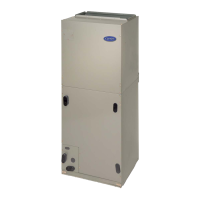ratingplateto see if it matches required piston shown on outdoor
unit rating plate. If it does not match, replace indoor piston with
piston shipped with outdoor unit. The piston shipped with outdoor
unit is correct for any approved indoor coil combination (See Fig.
19). When changing piston, use a back-up wrench. Hand tighten
hex nut, then tighten with wrench 1/2 turn. Do not exceed 30
ft-lbs.
NOTE: The indoor piston contains a Teflon ring (or seal) which is
used to seat against the inside of distributor body, and must be
installed properly to ensure proper seating in the direction for
cooling operation.
FY5B units also contain a factory installed Piston with Teflon ring
for sizes 018 thru 048 only. The FY5B-060 size units come
equipped with a Puron refrigerant TXV.
Always use outdoor units designed to match indoor fan coil
applications.
BRASS_
HEX NUT\ TEFLON SEAL
\
)_, TEFLON RiNG
PISTON
l
1
1
FLOW iN
COOLING
PISTON
RETAINER
BRASS
HEX BODY
STRAINER
[]NIT OR PROPERTY DAMAGE HAZARD
Failure to follow this caution may result in product or
property damage.
The conversion of the fan coil to downflow requires special
procedures for the condensate drains on both A-coil and
slope units. The vertical drains have an overflow hole
between the primary and secondary drain holes. This hole is
plugged for all applications except downflow, but must be
used for downflow. During the conversion process, remove
the plastic cap covering the vertical drains only and discard.
Remove the plug from the overflow hole and discard. At
completion of the downflow installation, caulk around the
vertical pan fitting to door joint to retain the low air leak
performance of the unit.
Units are equipped with primary and secondary 3/4-in. FPT drain
connections. For proper condensate line installations see Fig. 1, 2,
3, 5 and 6. To prevent property damage and achieve optimum
drainage performance, BOTH primary and secondary drain lines
should be installed and include properly-sized condensate traps.
(See Fig. 20 and 21.) Factory-approved condensate traps are
available. It is recommended that PVC fittings be used on the
plastic condensate pan. Finger-tighten plus 1-1/2 turns. Do not
over-tighten. Use pipe dope.
PROPERTY DAMAGE HAZARD
Failure to follow this caution may result in product or
property damage.
Shallow running traps are inadequate and DO NOT allow
proper condensate drainage. (See Fig. 22.)
A09677
Fig. 19 - Refrigerant Flow - Control Device
PRODUCT OPERATION HAZARD
Failure to follow this caution may result in improper product
operation.
If using a TXV in conjunction with a single-phase
reciprocating compressor, a compressor start capacitor and
relay are required. Consult outdoor unit pre-sale literature for
start assist kit part number.
Step 7 -- Condensate Drains
To connect drains, the cap openings must be removed. Use a knife
to start the opening near the tab and using pliers, pull the tab to
remove the disk. Clean the edge of the opening if necessary and
install the condensate line. Finally caulk around the lines where
they exit the fitting to retain the low leak rating of the unit.
UNiT
f
2" M[N
(51 ram)
Fig. 20 - Recommended Condensate Trap
A03002

